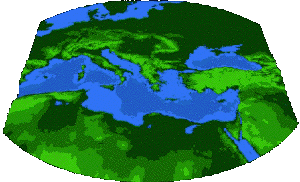EOL 3: Music, Myth, and History (Bohlman) |
|
|
6. Music and the Construction of Utopias Whereas many religious communities left Europe to find the path to a sacred paradise, there were other diasporic movements that left Europe in order to find a secular paradise. Utopias first appear in the European imagination in the late seventeenth century, when they represented both an escape from European society itself and an encounter with an idealized other (cf., however, St. Augustine's "City of God"). We are perhaps best acquainted with utopias in the literature of the eighteenth century, especially as it served as an encounter with the naturalness of the New World. Daniel Defoe's novel, Robinson Crusoe, was the first novel to set the stage for a utopia and to establish it as a cultural confrontation between Europe and its others, in the case of Robinson Crusoe, with "the Man Friday." Utopias actually proliferated--in literature, in reality, and in musical metaphor (see Becker 1996)--and by the beginning of the nineteenth century, the search for utopias was one of the most powerful forms of diaspora and the myths of modernity. There are many other reasons that utopian and pietistic cultures contribute to our understanding of diaspora as a myth of modernity. These cultures, often to great extreme, openly reject modernity, for example, in their dress. This is most familiar to us from the representations of the Amish, who wear only simple black-and-white clothing and avoid electric machines because these connect them with the modern world. The migration itself, that is the physical journey of the diaspora, also follows a path of rejection and resistance (cf. the Canadian Mennonite history inscribed through song in Klassen 1989). The sacred journey of diaspora, then, receives its impetus from the images of modernity from which it flees. It is for such reasons that utopian and pietistic diasporas transform the music culture of a European land of origin, without, however, abandoning that music culture completely. After four hundred years of diaspora, the Amish still sing in German, if indeed a German that most closely resembles a language spoken in the sixteenth century. |
| Music plays an extraordinarily important historical role in utopian and pietistic communities. Not only does music distinguish these communities from the world around them, thus strengthening the feeling of diaspora, but it encodes the essential narrative of the community's history. A Hutterite or Amish hymn, such as that in the Amish hymnbook, the Ausbund, is strophic in form, with verse after verse--some songs go on for hundreds of verses--explaining the historical path of martyrdom and resistance. Each time these songs are sung, the history of diaspora is remembered and made real to provide the modern context for the diaspora. The images of historical resistance may be vivid, for example, when a martyr meets his or her death in a pietistic song, or it may be hidden in a complex, internal structure. The style of singing heard in the recorded excerpt from "Lebt friedsam, sprach Christus"--slow, monophonic with lining-out of the verses, almost without pulse--resists modernity, as if to refuse to adapt to modernity, from which such communities escape along the path of diaspora. | |
Graphic 3: German-American Shape-Note Hymn, "Pilgrim/Wer nur hier will etwas seyn" ("He/She, Who Wants To Be Something Here")
|
|
The musical landscapes of Europe, such as those encountered by the immigrant musicians whom Karl Signell examines in this issue of EOL, look different in North America, and I should like to turn to a few of the reasons why this is so (cf. also Slobin 1993). One of the most distinctively American aspects of the musical landscapes of modernity is the sacred history of most American musics. Sacred music in America is the music of the everyday experience; it is not reserved solely for special festivals or removed from the everyday by ritual. Accordingly, the sacred journey of American history becomes an experience that represents American Selfness by creating modern and postmodern juxtapositions of Otherness. The sacred journey of modern music history is unified by difference in the United States. In European modernism, however, the sacred and the secular confront each other with double meanings of musical symbolism. Sacred music lays claim to the secular, for example, in Northern Ireland, where musical practices of Catholicism and Protestantism mark the borders of conflict. It is perhaps the case that this conflict between sacred and secular does only represent modern political boundary struggles; the Jesuits, for example, used music as a sacred weapon in the spread of European culture as a part of the Counter-Reformation. The spread of new genres of Muslim religious music in Bosnia-Hercegovina, notably the qasida, becomes even more understandable against this backdrop of modernism. |
|
 Illustration Three: Physical Map |
|
| European canons did form on some musical landscapes of the diaspora, but often in unchecked and almost random fashion. It is for this reason that we might think of an initial stage of diaspora during which an explosion of musical canons took place. The explosion or multiplication of musical canons, however, tended to work against the real spread of Europeanness, but rather led to a blurring of boundaries between Selfness and Otherness. Cultures in diaspora shared more with each other than they did with Europe, which meant that new forms of border-crossing developed. Music was one of the most powerful ways of representing such border-crossing and of physically making it possible. Music translated the histories of different diaspora communities into common or at least shared experiences. | |
